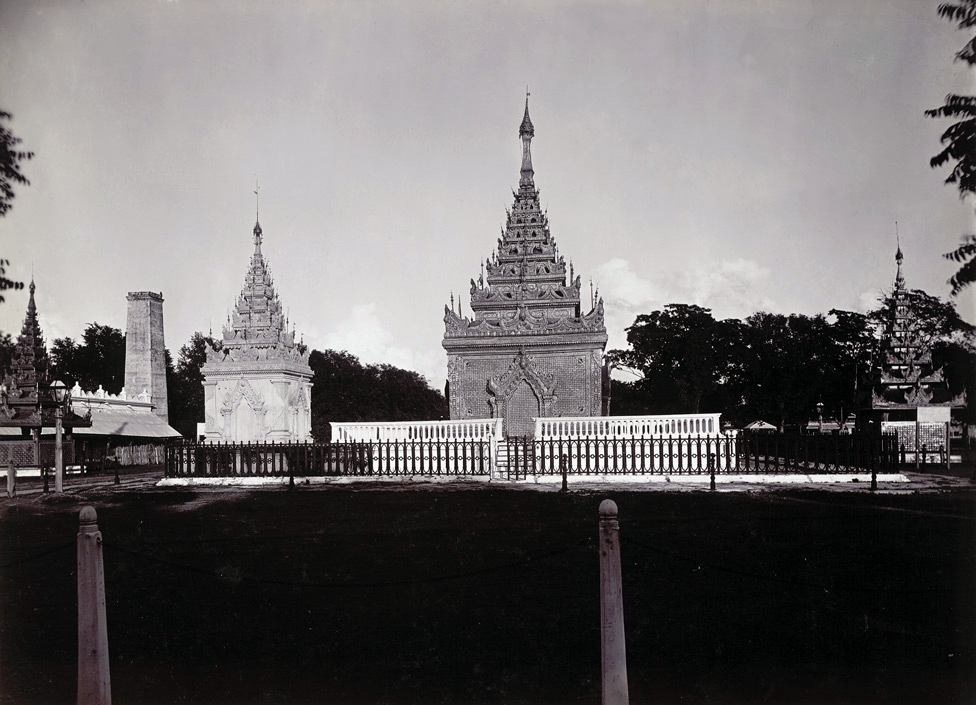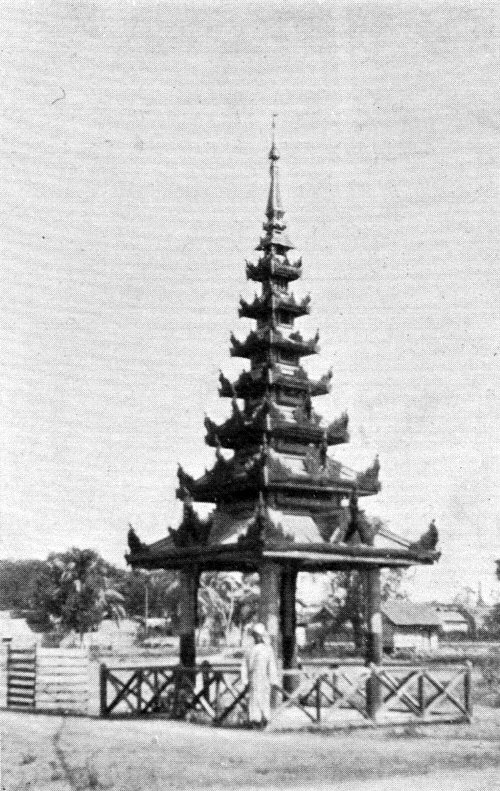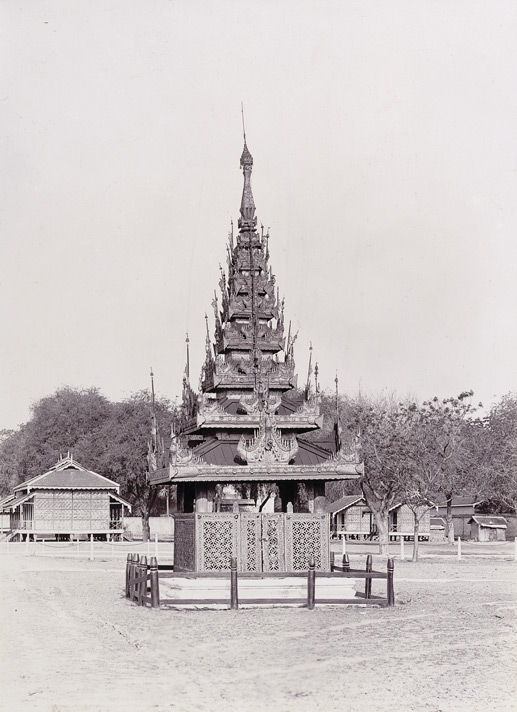|
Konbaung Tombs
The Konbaung tombs are a collection of mausoleums built by Konbaung dynasty kings. They are scattered throughout the former royal capitals of Mandalay Region, including Mandalay, Amarapura, and Inwa. Burial traditions When a Burmese king died, his royal white umbrella was broken and the great drum and gong at the palace's bell tower (at the eastern gate of the palace), was struck. It was custom for members of the royal family, including the king, to be cremated: their ashes were put into a velvet bag and thrown into the river. King Mindon Min was the first to break tradition; his remains were not cremated, but instead were buried intact, according to his wishes, at the place where his tomb now stands. Before his burial, the King Mindon's body was laid in state before his throne at the Hmannandawgyi (Palace of Mirrors). List of tombs Amarapura #Tomb of King Bodawphaya (Amarapura) – King Bodawpaya reigned from 1781 to 1810, i.e., for 38 years. His was the longest reign among ... [...More Info...] [...Related Items...] OR: [Wikipedia] [Google] [Baidu] |
King Mindon's Tomb, Mandalay
King is the title given to a male monarch in a variety of contexts. The female equivalent is queen, which title is also given to the consort of a king. *In the context of prehistory, antiquity and contemporary indigenous peoples, the title may refer to tribal kingship. Germanic kingship is cognate with Indo-European traditions of tribal rulership (c.f. Indic ''rājan'', Gothic ''reiks'', and Old Irish ''rí'', etc.). *In the context of classical antiquity, king may translate in Latin as '' rex'' and in Greek as ''archon'' or ''basileus''. *In classical European feudalism, the title of ''king'' as the ruler of a ''kingdom'' is understood to be the highest rank in the feudal order, potentially subject, at least nominally, only to an emperor (harking back to the client kings of the Roman Republic and Roman Empire). *In a modern context, the title may refer to the ruler of one of a number of modern monarchies (either absolute or constitutional). The title of ''king'' is used ... [...More Info...] [...Related Items...] OR: [Wikipedia] [Google] [Baidu] |
Mahamuni Buddha
The Mahamuni Buddha Temple ( my, မဟာမုနိဘုရားကြီး, ) is a Buddhist temple and major pilgrimage site, located southwest of Mandalay, Myanmar (Burma). The Mahamuni Image () is enshrined in this temple, and originally came from Arakan. It is highly venerated in Burma and central to many people's lives, as it is seen as an expression of representing the Buddha's life. Ancient tradition refers to only five likenesses of the Buddha made during his lifetime; two were in India, two in paradise, and the fifth is thMahamuniImage in Myanmar. Legend holds that the Buddha himself visited the Dhanyawadi city of Arakan in 554 BC. King Sanda Thuriya requested that an image be cast of him. Once complete, the Buddha breathed upon it, and thereafter the image took on his exact likeness. History Origins According to legend, the Gautama Buddha visited Dhanyawadi, the capital city of Arakan during his travels on a missionary mission to spread Buddhism. During the 26th ... [...More Info...] [...Related Items...] OR: [Wikipedia] [Google] [Baidu] |
Ratnagiri
Ratnagiri (IAST:Ratnāgirī ; �ət̪n̪aːɡiɾiː is a port city on the Arabian Sea coast in Ratnagiri District in the southwestern part of Maharashtra, India. The district is a part of Konkan division of Maharashtra. The city is known for the Hapus or Alphonso mangoes. Ratnagiri is the birthplace of Indian independence activist Lokmanya Tilak. Thibaw, the last king of Burma, alongside his consort Supayalat and two infant daughters were exiled to a two-storied brick mansion in Ratnagiri. The building is now known as Thibaw Palace. Geography Ratnagiri is located at . It has an average elevation of 11 meters (36 feet). The Sahyadri mountains border Ratnagiri to the east Climate Transport Road Ratnagiri is well connected to the other parts of the state and country by National Highways & State Highways. National Highways NH 66 ( Panvel – Edapally ), NH 166 ( Ratnagiri – Nagpur ) and Coastal Highway ( Rewas – Reddy ) pass through the city. MSRTC operate ... [...More Info...] [...Related Items...] OR: [Wikipedia] [Google] [Baidu] |
Shwebo
Shwebo ( my, ရွှေဘိုမြို့ ) is a city in Sagaing Region, Burma, 110 km north-west of Mandalay between the Irrawaddy and the Mu rivers. The city was the origin of the Konbaung Dynasty, established by King Alaungpaya in 1752, that was the dominant political force in Burma after the mid-18th century. It served as Alaungpaya's capital from 1752 to 1760. As of 2021, it has a population of 88,914. History Up to 1752, Shwebo was a village, called Moksobo ( my, မုဆိုးဘို ; ) of about 300 houses. It lies near the site of the ancient Pyu city-state of Hanlin. On 29 February 1752, the chief of the village Aung Zeya founded the Konbaung Dynasty to resist the upcoming invasion of Lower Burma-based Hanthawaddy forces. Aung Zeya, who also assumed the royal title of Alaungpaya, gained the allegiance of 46 surrounding villages, and organized defenses building a stockade and digging a moat around Moksobo. He renamed his village, Shwebo (). Over th ... [...More Info...] [...Related Items...] OR: [Wikipedia] [Google] [Baidu] |
Alaungpaya
Alaungpaya ( my, အလောင်းဘုရား, ; also spelled Alaunghpaya or Alaung-Phra; 11 May 1760) was the founder of the Konbaung Dynasty of Burma (Myanmar). By the time of his death from illness during his campaign in Siam, this former chief of a small village in Upper Burma had unified Burma, subdued Manipur, conquered Lan Na and defeated the French and the British who had given help to the Restored Hanthawaddy Kingdom. He added settlements around Dagon, and called the enlarged town Yangon.Letwe Nawrahta and Maha Sithu of Twinthin 1961: 190–191 He is considered one of the three greatest monarchs of Burma alongside Anawrahta and Bayinnaung for unifying Burma for the third time in Burmese history. Background The future king was born Aung Zeya ( "Victorious Victory") at Moksobo, a village of a few hundred households in the Mu River Valley about northwest of Ava (Inwa) on 24 August 1714 to Min Nyo San () and his wife Saw Nyein Oo (). He was the second son of a ... [...More Info...] [...Related Items...] OR: [Wikipedia] [Google] [Baidu] |
Laungshe Mibaya
Thiri Mahamingala Thupabadewi ( my, သီရိမဟာမင်္ဂလာသုပဘာဒေဝီ; pi, Sirimahāmaṅgalasupabhādevī; 1825 – after 1890), commonly known as the Laungshe Mibaya or Queen of Laungshe ( my, လောင်းရှည် မိဖုရား), was a royal princess and senior queen consort of King Mindon during the Konbaung dynasty. She was the queen mother of the Konbaung dynasty's last king, Thibaw Min. Being a cousin of King Mindon, she was promoted to a Nanzwe MibayaKing Mindon created a special position called Nanzwe Mibaya for his four queens– Yinge Mibaya, Laungshe Mibaya, Magway Mibaya and Seindon Mibaya. It's between Nanya Mibaya (first rank) and Ahsaungya Mibaya (second rank). and received the appanage of Laungshe when he ascended the throne. Among her other children included 3 daughters, the Mong Kung Princess, Pakhangyi Princess, Meiktila Princess. She was of Shan extraction, it's seems her grandmother by her father name ... [...More Info...] [...Related Items...] OR: [Wikipedia] [Google] [Baidu] |


.jpg)



